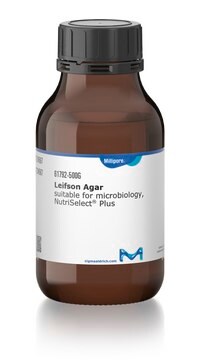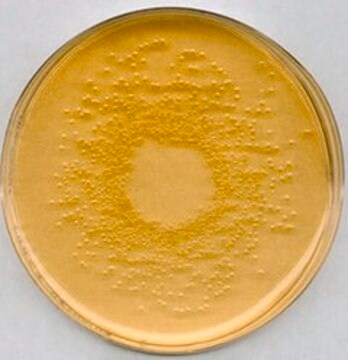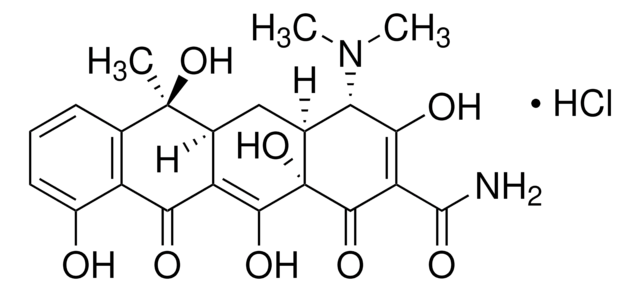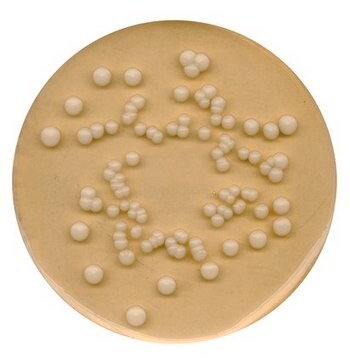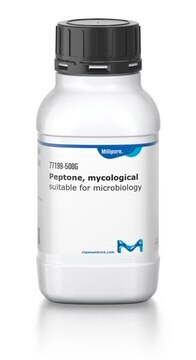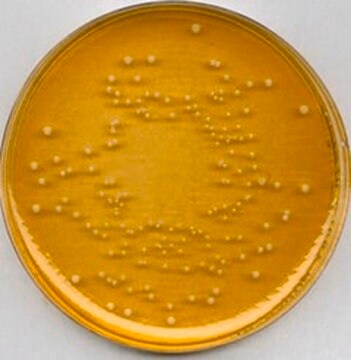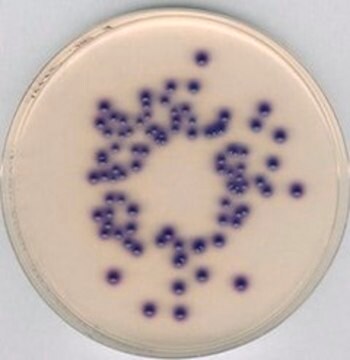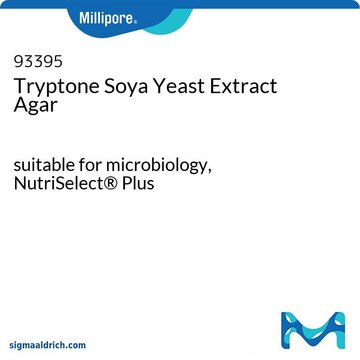75315
OF-Test-Nährstoffagar
suitable for microbiology, NutriSelect® Basic
Synonym(e):
Oxidation-Fermentation-Testagar nach Hugh u. Leifson
About This Item
Empfohlene Produkte
Sterilität
non-sterile
Qualitätsniveau
Produktlinie
BioChemika
Form
powder
Haltbarkeit
limited shelf life, expiry date on the label
Zusammensetzung
agar, 2.5 g/L
bromothymol blue, 0.08 g/L
casein peptone (pancreatic), 2 g/L
dipotassium hydrogen phosphate, 0.3 g/L
sodium chloride, 5 g/L
Hersteller/Markenname
NutriSelect® Basic
Methode(n)
microbe id | utilization test: suitable
microbiological culture: suitable
pH-Endwert
7.1±0.2 (25 °C)
Wirkungsspektrum von Antibiotika
Gram-negative bacteria
Anwendung(en)
agriculture
clinical testing
environmental
food and beverages
microbiology
Eignung
Alcaligenes spp.
Chromobacterium spp.
Moraxella spp.
Pasteurella spp.
Acinetobacter spp.
Aeromonas spp.
flavobacteria
nonselective and differential for Bordetella spp.
nonselective and differential for Campylobacter spp.
nonselective and differential for Enterococcus spp.
nonselective and differential for Escherichia coli
nonselective and differential for Pseudomonas spp.
nonselective and differential for Salmonella spp.
nonselective and differential for Shigella spp.
nonselective and differential for Vibrio spp.
nonselective and differential for Yersinia spp.
nonselective and differential for bacteria (General Media)
nonselective and differential for coliforms
nonselective and differential for enterobacteriaceae
Anwendung
Angaben zur Herstellung
Sonstige Hinweise
Fußnote
The designations basic, plus, or prime are added to indicate the quality control level, from basic quality control to standard QC plus to prime for full regulatory compliance.
Rechtliche Hinweise
Lagerklassenschlüssel
11 - Combustible Solids
WGK
WGK 2
Flammpunkt (°F)
Not applicable
Flammpunkt (°C)
Not applicable
Persönliche Schutzausrüstung
Eyeshields, Gloves, type N95 (US)
Hier finden Sie alle aktuellen Versionen:
Analysenzertifikate (COA)
Die passende Version wird nicht angezeigt?
Wenn Sie eine bestimmte Version benötigen, können Sie anhand der Lot- oder Chargennummer nach einem spezifischen Zertifikat suchen.
Besitzen Sie dieses Produkt bereits?
In der Dokumentenbibliothek finden Sie die Dokumentation zu den Produkten, die Sie kürzlich erworben haben.
Kunden haben sich ebenfalls angesehen
Artikel
Vibrios are motile, curved or comma-shaped bacilli and have a single polar flagella with sheet proteins. They are often found in open water, freshwater and saltwater.
On the Trail of Campylobacter - The Campylobacter is one of the leading causes of human gastroenteritis. Common Campylobacter species C. jejuni, C. coli, and C. lari are responsible for most cases of campylobacteriosis. However, other species, like C. fetus, which causes spontaneous abortions, have also been associated with human illness. Campylobacter are Gram-negative, spiral-shaped, microaerophilic and motile bacteria with uni- or bi-polar fl agella
Campylobacter spp. are regarded as the leading cause of bacterial gastroenteritis in humans worldwide.
Salmonella contamination is the second leading cause of food-borne illness worldwide. Controlling outbreaks of Salmonella is an important task for food regulators, restaurants and the food industry in general. The Salmonella family includes over 2,300 serotypes of bacteria, but two types, Salmonella enteritidis and Salmonella typhimurium, are responsible for about half of all human infections. Most outbreaks of Salmonella are traced back to dairy, poultry and meat products, but Salmonella can grow on nearly any food. Chicken, eggs and their derivative products are particularly high risk.
Unser Team von Wissenschaftlern verfügt über Erfahrung in allen Forschungsbereichen einschließlich Life Science, Materialwissenschaften, chemischer Synthese, Chromatographie, Analytik und vielen mehr..
Setzen Sie sich mit dem technischen Dienst in Verbindung.